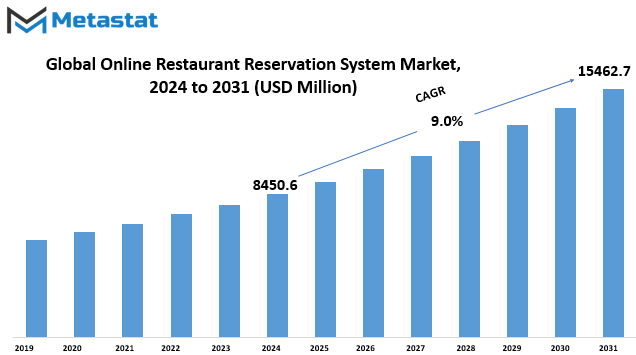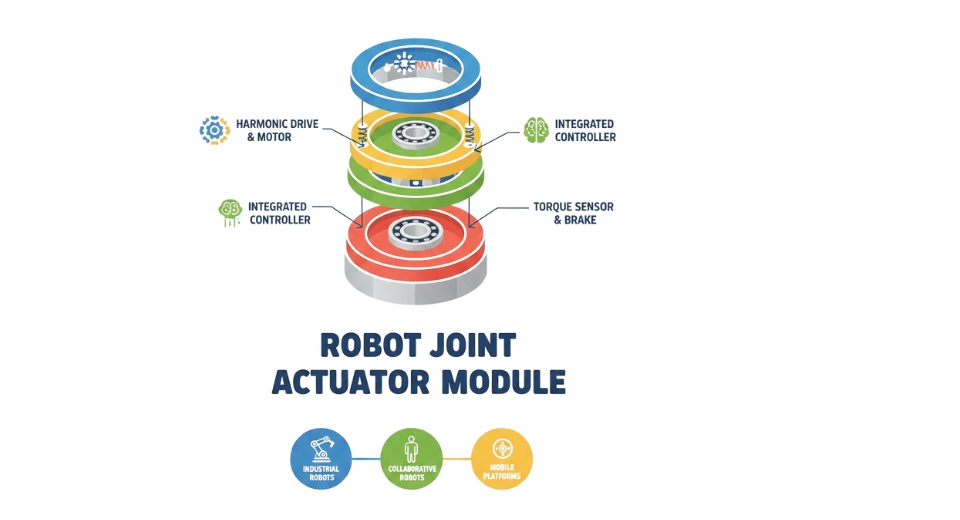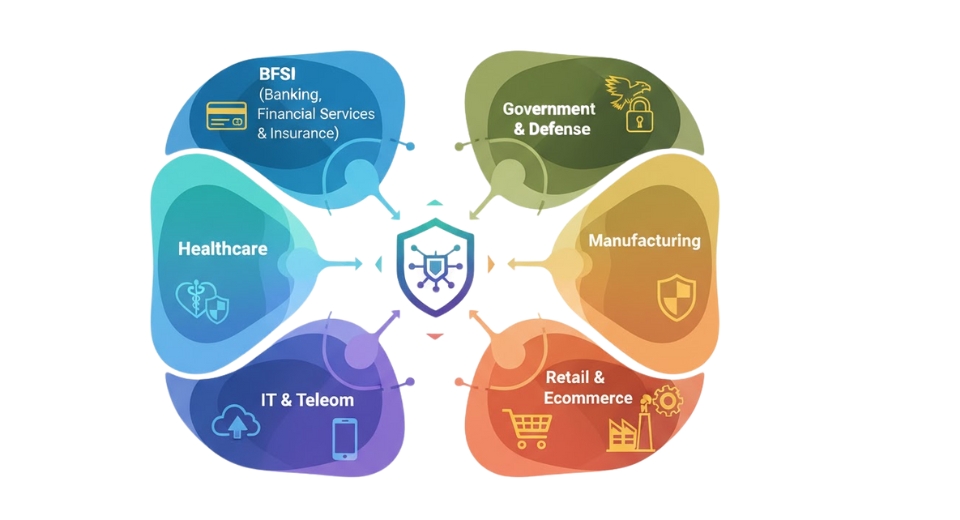MARKET OVERVIEW
The Global Online Restaurant Reservation System market, within the hospitality industry, represents a dynamic ecosystem driven by technological advancements and changing consumer preferences. This niche sector facilitates the seamless booking of dining experiences through digital platforms, revolutionizing the way patrons interact with restaurants worldwide.
Within the restaurant industry, the Online Restaurant Reservation System market has emerged as a pivotal tool for both establishments and diners alike. This innovative platform enables customers to browse, select, and reserve tables at their preferred restaurants, offering convenience and efficiency in the dining experience. Likewise, restaurants benefit from optimized table management, reduced no-show rates, and increased customer engagement facilitated by these digital solutions.
The industry's landscape is characterized by a myriad of online reservation platforms, each offering unique features and services tailored to meet the diverse needs of both consumers and businesses. From comprehensive booking systems integrated with restaurant management software to standalone reservation apps, the market offers a spectrum of solutions designed to streamline the dining experience.
One of the key drivers shaping the Global Online Restaurant Reservation System market is the growing adoption of digital technologies across the hospitality sector. With the proliferation of smartphones and the internet, consumers increasingly seek convenient ways to discover, book, and review dining options, driving demand for online reservation platforms. Moreover, the COVID-19 pandemic has accelerated this trend, as restaurants embrace contactless solutions to comply with health and safety protocols.
In addition to enhancing the booking process, online reservation systems empower restaurants with valuable insights into customer behavior and preferences. By leveraging data analytics tools, establishments can optimize their operations, personalize marketing efforts, and improve customer satisfaction levels. This data-driven approach not only fosters loyalty but also enables restaurants to adapt to evolving market trends and consumer preferences.
Furthermore, the Global Online Restaurant Reservation System market fosters innovation and competition, with companies constantly striving to differentiate themselves through unique features and partnerships. From integrating virtual waitlists and predictive analytics to collaborating with food delivery platforms, industry players continue to explore new avenues to enhance the dining experience and capture market share.
Despite its transformative potential, the Online Restaurant Reservation System market faces challenges such as data privacy concerns, cybersecurity risks, and the need for seamless integration with existing restaurant management systems. Moreover, as the industry evolves, regulatory frameworks and industry standards may play a crucial role in shaping its future trajectory.
The Global Online Restaurant Reservation System market represents a dynamic and rapidly evolving sector within the broader hospitality industry. By harnessing the power of digital technology, online reservation platforms offer a seamless and convenient dining experience for consumers while empowering restaurants with valuable insights and operational efficiencies. As the market continues to evolve, innovation, adaptation, and collaboration will remain key drivers of growth and success in this dynamic industry landscape.
Global Online Restaurant Reservation System market is estimated to reach $15462.7 Million by 2031; growing at a CAGR of 9.0% from 2024 to 2031.

GROWTH FACTORS
The global online restaurant reservation system market is experiencing significant growth, driven by several key factors. These factors play a crucial role in propelling the market forward. However, certain challenges also exist that could potentially hinder this growth. Despite these challenges, there are promising opportunities on the horizon that could further stimulate market expansion in the future.
One of the primary growth factors contributing to the expansion of the global online restaurant reservation system market is the increasing adoption of digital solutions by restaurants worldwide. As more restaurants recognize the benefits of utilizing online reservation systems, such as improved efficiency, enhanced customer experience, and increased operational convenience, the demand for these solutions continues to rise. This trend is further fueled by consumers' growing preference for online booking platforms, which offer convenience and flexibility in making dining arrangements.
Furthermore, the proliferation of smartphones and internet connectivity has significantly impacted the market's growth trajectory. With most consumers now owning smartphones and accessing the internet, online restaurant reservation systems have become more accessible and convenient than ever. This widespread adoption of mobile technology has enabled customers to make reservations on-the-go, anytime and anywhere, further driving the demand for online reservation services.
Another important factor contributing to market growth is the increasing competition among restaurants to attract and retain customers. In today's highly competitive dining industry, restaurants are constantly seeking innovative ways to differentiate themselves and enhance their appeal to consumers. Adopting online reservation systems allows restaurants to streamline their operations, improve table management, and offer personalized services, thereby gaining a competitive edge in the market.
However, despite the promising growth prospects, the global online restaurant reservation system market also faces certain challenges that could potentially impede its expansion. One such challenge is the reluctance of some restaurants to adopt digital solutions due to concerns about cost, complexity, and integration issues. Additionally, resistance from traditional establishments and cultural preferences in certain regions may hinder the widespread adoption of online reservation systems in those areas.
Moreover, data security and privacy concerns pose another significant challenge for the market. With the increasing prevalence of cyber threats and data breaches, consumers are becoming more cautious about sharing their personal information online. This heightened awareness regarding data security could deter some customers from using online reservation platforms, thereby limiting the market's growth potential.
Despite these challenges, the global online restaurant reservation system market is poised to capitalize on various opportunities in the coming years. One such opportunity lies in the integration of advanced technologies, such as artificial intelligence and machine learning, to enhance the functionality and user experience of reservation systems. By leveraging these technologies, vendors can offer more personalized recommendations, predictive analytics, and seamless booking experiences, thereby attracting more customers and driving market growth.
The global online restaurant reservation system market is experiencing robust growth driven by factors such as increasing digital adoption, smartphone proliferation, and rising competition among restaurants. However, challenges such as cost concerns, cultural barriers, and data security issues persist. Nevertheless, the market remains ripe with opportunities, particularly through the integration of advanced technologies to enhance system capabilities and user satisfaction.
MARKET SEGMENTATION
By Type
The global online restaurant reservation system market is a dynamic and expansive sector that caters to the needs of both consumers and businesses within the food service industry. This market encompasses various types of reservation systems, each offering unique features and benefits to users. One of the key distinctions within this market is the segmentation based on type, with two main categories being on-premises and cloud-based systems.
On-premises reservation systems are those installed and operated directly on the restaurant premises. These systems are typically managed by the restaurant staff and require physical hardware and software installations. One of the main advantages of on-premises systems is that they offer a high level of control and customization to restaurant owners and managers. They can tailor the system to meet their specific needs and preferences, and they have full access to all data and functionalities without relying on external servers or internet connectivity.
However, on-premises reservation systems also have some limitations. They require significant upfront investment in hardware and software, as well as ongoing maintenance and updates. Additionally, they may lack some of the advanced features and integrations available in cloud-based systems, such as real-time data analytics and mobile accessibility. Despite these drawbacks, on-premises systems remain a popular choice for many restaurants, especially those with specific security or regulatory requirements.
On the other hand, cloud-based reservation systems are hosted and managed remotely by third-party providers. These systems operate entirely in the cloud, meaning that users can access them from any internet-enabled device without the need for physical installations or maintenance. Cloud-based systems offer several advantages over on-premises solutions, including scalability, flexibility, and cost-effectiveness. Restaurants can quickly scale their reservation capabilities up or down in response to changing demand, and they can access the latest features and updates without any additional costs or efforts.
Furthermore, cloud-based reservation systems often come with built-in integrations and APIs that allow seamless connectivity with other software applications, such as point-of-sale systems, customer relationship management tools, and marketing platforms. This integration enables restaurants to streamline their operations, improve customer experiences, and gain valuable insights into their business performance.
Despite their numerous benefits, cloud-based reservation systems may pose some concerns regarding data security and privacy. Since the data is stored and processed on external servers managed by third-party providers, there is always a risk of unauthorized access or data breaches. However, reputable providers employ robust security measures and compliance standards to mitigate these risks and ensure the confidentiality and integrity of their users’ data.
The global online restaurant reservation system market offers a wide range of options for businesses seeking to streamline their operations and enhance customer experiences. Whether opting for an on-premises or cloud-based solution, restaurants must carefully consider their specific needs, budget, and preferences to choose the most suitable reservation system for their establishment. With the right system in place, restaurants can efficiently manage reservations, optimize table turnover, and ultimately drive profitability and growth.
By Application
In today’s digital age, the global online restaurant reservation system market is witnessing remarkable growth. This market, which facilitates the booking of tables at restaurants through online platforms, is expanding rapidly due to the increasing adoption of technology by both consumers and restaurant owners.
The market is segmented based on application into dining rooms, bars, and other areas. This segmentation allows for a more tailored approach to meeting the needs of different types of establishments within the hospitality industry. By catering to specific requirements, online reservation systems can enhance the dining experience for customers while streamlining operations for restaurant staff.
One of the key drivers behind the growth of the online restaurant reservation system market is the convenience it offers to consumers. With just a few clicks or taps on their smartphones, diners can secure a table at their favorite restaurant without the hassle of making a phone call or waiting in line. This convenience factor has led to a surge in the popularity of online reservation platforms among consumers who value efficiency and time saving solutions.
Moreover, online reservation systems provide restaurant owners with valuable insights into customer preferences and behavior. By analyzing data collected through these platforms, restaurants can better understand their target audience and tailor their offerings accordingly. This data-driven approach enables restaurants to optimize their operations, improve customer satisfaction, and ultimately drive revenue growth.
The global online restaurant reservation system market is experiencing rapid growth driven by factors such as convenience, efficiency, data-driven insights, and the demand for contactless dining solutions. By leveraging technology to streamline operations and enhance customer satisfaction, online reservation systems are revolutionizing the way restaurants operate in today’s competitive landscape.

REGIONAL ANALYSIS
The global market for online restaurant reservation systems can be analyzed regionally to understand its dynamics across different parts of the world. This regional analysis provides insights into the specific trends and factors influencing the adoption and growth of these systems.
North America stands out as a significant player in the global online restaurant reservation system market. Within North America, the United States, Canada, and Mexico are key contributors to market growth. These countries have well-established restaurant industries and a high level of internet penetration, which facilitates the adoption of online reservation systems among both restaurants and consumers.
Moving to Europe, the market is segmented into various countries, including the United Kingdom, Germany, France, Italy, and the Rest of Europe. Each of these countries has its own unique culinary culture and dining preferences, influencing the demand for online reservation systems. The mature restaurant market in Europe, coupled with the increasing digitalization of services, drives the adoption of online reservation platforms across the region.
In the Asia-Pacific region, countries such as India, China, Japan, and South Korea play a significant role in shaping the online restaurant reservation system market. With a growing middle class and increasing disposable income, dining out has become more popular in these countries. As a result, restaurants are increasingly adopting online reservation systems to cater to the preferences of tech savvy consumers.
South America, comprising countries like Brazil and Argentina, is also witnessing a growing demand for online restaurant reservation systems. The region's vibrant culinary scene, coupled with a rising urban population, drives the need for efficient reservation management solutions among restaurants.
The Middle East & Africa region presents opportunities for growth in the online restaurant reservation system market. Countries within this region, such as the GCC countries, Egypt, and South Africa, are experiencing rapid urbanization and changing consumer lifestyles. As a result, there is an increasing inclination towards dining out, leading to a growing demand for online reservation systems to streamline the dining experience.
The regional analysis of the global online restaurant reservation system market highlights the diverse factors influencing market growth across different parts of the world. From the mature markets of North America and Europe to the emerging economies of Asia-Pacific and South America, and the evolving landscape of the Middle East & Africa, each region presents unique opportunities and challenges for players in the online restaurant reservation system market. Understanding these regional dynamics is crucial for businesses aiming to expand their presence and capitalize on the growing demand for online reservation solutions in the global restaurant industry.
COMPETITIVE PLAYERS
In the vast landscape of the global online restaurant reservation system market, several key players stand out, each vying for a competitive edge in this dynamic industry. These players shape the landscape of online dining reservations, offering solutions and services to restaurants and diners alike.
Eat App, Resy Network, Inc., Olo Inc. (Wisely), Squarespace, Inc. (Tock), and OpenTable are among the leading contenders in this market. They provide platforms and tools that enable restaurants to manage their reservations efficiently while offering diners a seamless booking experience.
Eat App offers a comprehensive reservation management system tailored to the needs of restaurants, allowing them to streamline their booking processes and optimize table occupancy. Resy Network, Inc. provides a user-friendly platform for both restaurants and dinners, facilitating easy booking and managing reservations on-the-go.
Olo Inc., operating under the brand Wisely, specializes in guest management solutions that help restaurants enhance their customer experience and improve operational efficiency. Squarespace, Inc., known for its Tock platform, offers innovative reservation and ticketing solutions designed to elevate the dining experience and empower restaurants to better manage their bookings.
OpenTable, perhaps one of the most well-known players in the online reservation space, boasts a vast network of restaurants and diners worldwide. Its user-friendly interface and robust features make it a popular choice for both restaurants and diners seeking hassle-free reservation management and booking experiences.
These competitive players continuously innovate and evolve their offerings to stay ahead in the market. From introducing new features to enhancing user experiences, they strive to meet the changing needs and preferences of both restaurants and diners in an ever-evolving industry landscape.
In addition to providing reservation management solutions, these key players also play a crucial role in shaping the future of dining experiences. Through data analytics and insights, they help restaurants understand consumer behavior and preferences, allowing them to tailor their offerings and marketing strategies accordingly.
Moreover, the online reservation system market is not only competitive but also collaborative to some extent. While these players compete for market share, they also collaborate with restaurants and other industry stakeholders to drive innovation and growth collectively.
The global online restaurant reservation system market is a vibrant and competitive arena, with key players such as Eat App, Resy Network, Inc., Olo Inc. (Wisely), Squarespace, Inc. (Tock), and OpenTable shaping its landscape. As they continue to innovate and adapt to changing trends, they play a pivotal role in revolutionizing the dining experience for restaurants and diners worldwide.
Online Restaurant Reservation System Market Key Segments:
By Type
- On-premises
- Cloud Based
By Application
- Dining Room
- Bar
- Others
Key Global Online Restaurant Reservation System Industry Players
- Eat App
- Resy Network, Inc.
- Olo Inc.(Wisely)
- Squarespace, Inc. (Tock)
- OpenTable, Inc.
- DISH Digital Solutions GmbH
- Eveve Limited Software
- Zenchef
- CoverManager
- Sugarvine Tables
- Kernow Software Ltd (e-Res)
- Hostme LLC
- KB Logic Ltd (Avenista)
- Tablein
- Quandoo GmbH
WHAT REPORT PROVIDES
- Full in-depth analysis of the parent Industry
- Important changes in market and its dynamics
- Segmentation details of the market
- Former, on-going, and projected market analysis in terms of volume and value
- Assessment of niche industry developments
- Market share analysis
- Key strategies of major players
- Emerging segments and regional growth potential








 US: +1 3023308252
US: +1 3023308252






